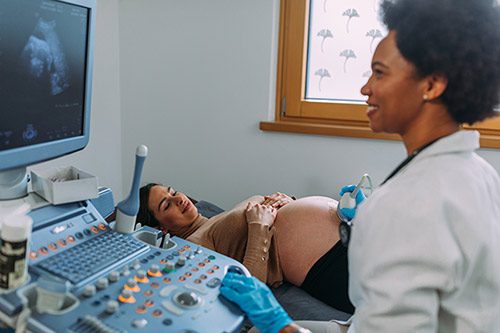An ultrasound is a prenatal test your doctor will offer you during your pregnancy (see a 20 week ultrasound below). Ultrasound uses sound waves to show how your baby is doing in your womb and displays these pictures to you in a sort of “ultrasound video” format. It helps your healthcare provider review your baby’s health and development.
Depending on when the ultrasound is done and how your baby is positioned, you might be able to see her hands, legs, head, and other body parts and hear her heartbeat. The sonographer will also be able to study your baby’s position and movements. You may even be able to tell if your baby will be a boy or a girl. If you don’t want to know your baby’s gender, be sure to tell your doctor and the ultrasound tech.

When you have a sonogram depends on your OB-GYN’s prenatal care protocol. Most women have an ultrasound at 18–22 weeks along, while others have ultrasounds as early as six or eight weeks. The amount of ultrasounds and timing may differ if you have certain health conditions like asthma or obesity. Talk to your doctor to learn when an ultrasound is right for you.
How do I prepare for an ultrasound?
It’s important to have a full bladder for your ultrasound exam because it will help the sonographer obtain better images so they can rule out possible complications.
You will first need to empty your bladder one hour before your appointment. Then, drink 24 – 32 ounces of water or a non-caffeinated beverage. Caffeine can make your bladder contract causing you to feel like you need to pee before your bladder is full. However, you should not be so full that it hurts. If it does get painful, empty your bladder just enough to relieve the pain. Do not empty your bladder completely until after your ultrasound. You can eat as you normally do before having a fetal ultrasound.
A full bladder will help the sound waves travel better through the skin and tissues. It will also push your uterus back so the ultrasound tech can better visualize the uterus, ovaries, cervix, baby, and placenta.
In any case, your OB-GYN will let you know if you need to do anything particular to prepare for your ultrasound. They may provide instructions during an appointment or when they schedule your ultrasound. If your doctor’s office uses an online system with your electronic medical records, you should also be able to find instructions there.
What happens during an ultrasound?
After arriving at the doctor’s office, you might be asked to change out of your clothing and into a medical gown. Consider wearing a two-piece outfit so the ultrasound technician can access your abdomen and you don’t have to remove all your clothing.
In general, ultrasounds follow these steps:
- You’ll lie on your back or side on a comfortable exam table.
- Next, the ultrasound technician will spread a small amount of gel on your skin over your stomach, which helps the ultrasound wand move more easily across your skin. It also allows the sound waves to transfer into your body. (Don’t worry; this gel is water-soluble and won’t harm your skin or stain your clothes.)
- The tech will then roll a handheld transducer over the gel to get images and an ultrasound video of your baby. You could feel light pressure on your stomach but no pain.
- You may be asked to be very still for a few seconds to make clearer pictures. Some techs will even ask you to hold your breath for a couple of seconds.
- After the technician has collected enough images in your ultrasound video, they’ll wipe any remaining gel off your skin, and you’re done!
An ultrasound test usually takes 30 minutes to an hour.
Why does my doctor want me to get an ultrasound?
Your healthcare provider uses ultrasound to do several things, including:
- Make sure that you’re pregnant
- Scan to see if you’re pregnant with more than one baby
- Calculate how long you’ve been pregnant and your anticipated due date
- Estimate the gestational age of the fetus
- Check your baby’s heartbeat, muscle tone, position, movement, and general development
- Study for birth defects
- Check the amount of amniotic fluid
Your medical care team also uses ultrasound results to screen for birth defects and other testing. Screening doesn’t mean finding out for sure if your baby has a health condition; it just means seeing if your baby is more likely than others to have it. Your doctor may want to do more tests, called diagnostic tests, to determine if your baby has a birth defect, such as spina bifida or heart defects.
An ultrasound can also help your doctor check for complications like molar pregnancy, ectopic pregnancy, and miscarriage.
Will the ultrasound video hurt my baby?
Having an ultrasound is safe for both you and your baby when your healthcare provider performs it. Because ultrasound uses sound waves and not radiation, it’s actually safer than X-rays, which use harmful radiation. Medical professionals have used ultrasound for over 50 years, and no dangerous risks have been found.
Ultrasound is painless, convenient, and provides immediate results. In addition, several studies have found it to be safe. Studies have found no link between ultrasound exposure and low birth weight, childhood cancers, dyslexia, or hearing issues. Still, all ultrasounds should be done by a professional who has been trained to use this specialized technology safely.
The American Institute of Ultrasound in Medicine (AIUM) and the American College of Obstetricians and Gynecologists (ACOG) do not recommend getting a “keepsake” 3-D or 4-D non-medical ultrasound. The people doing them might not have medical training. They may even give you wrong or harmful information.
Should I get a 7 week ultrasound?
Even though most women get an ultrasound around 18 weeks of pregnancy, some may have an ultrasound done in the first trimester (around seven weeks pregnant). An ultrasound done in early pregnancy will have less information than if you had this imaging test done at 12 weeks or later. Your healthcare provider will take a series of measurements of the embryo, the medical term for your growing baby until ten weeks of pregnancy.
Not all women need to have a 7 week ultrasound performed at seven weeks pregnant. Your doctor may recommend a 12 or 20 week ultrasound if you don’t have any health issues and your menstrual cycle is regular. Doctors usually recommend a seven-week ultrasound if a woman has a health condition, experiences bleeding, had a previous ectopic pregnancy, or is experiencing abdominal pain.
What happens during a seven-week ultrasound?
To get the closest, most precise picture of the embryo, medical professionals will typically perform a transvaginal ultrasound during early pregnancy. The ultrasound technician will insert a wand-like tool into the vagina and place it near the uterus.
If the seven-week ultrasound is successful, the gestational sac may be visible, a fluid-filled structure surrounding the embryo). You might also see the embryo, which won’t look like a baby yet. A seven-week ultrasound can verify your embryo’s age, confirm your pregnancy, and determine if you’re carrying multiples. Even though your baby’s heart is still forming at seven weeks pregnant, an ultrasound may reveal a heartbeat.
What emotions can I expect at my ultrasound?
Seeing your baby in an ultrasound video can cause a lot of mixed and unexpected emotions. If you’re placing your baby for adoption, this is especially true. For some expectant mothers choosing adoption, seeing their baby brings about feelings of grief, sadness, and disappointment, while others feel relieved or happy.
Your Adoption Coordinator is always here to give you the support you need and to help you prepare for these ultrasounds. Whether you are having a 7 week ultrasound or you are at your 20 week ultrasound. Lifetime is available to you 24/7 by calling or texting 1-800-923-6784. We’re always ready to listen to your concerns or answer any questions you may have. And remember that when you make an adoption plan with Lifetime Adoption, your medical costs should be able to be covered by the adoptive family you chose.
An unplanned pregnancy can be scary, so it’s completely normal to distance yourself from your situation. But seeing your baby or hearing its heartbeat for the first time can hit you hard. It’s normal to feel shock or numbness when this happens as you come to terms with your pregnancy.
As your pregnancy becomes more real to you, your adoption plans may also take on a new meaning for you. For some women, seeing their baby or hearing their heartbeat makes them realize what they’ll lose by placing. It’s normal to feel sad at any time during the adoption process, but having an ultrasound can emphasize this emotion.
Reach out and get the support you need at this time. Talk or text with one of our adoption professionals at 1-800-923-6784.
Editor’s Note: This article was originally published on August 14, 2015, and has since been updated.
As Vice President of Lifetime Adoption, Heather Featherston holds an MBA and is passionate about working with those facing adoption, pregnancy, and parenting issues. Heather has conducted training for birth parent advocates, spoken to professional groups, and has appeared on television and radio to discuss the multiple aspects of adoption. She has provided one-on-one support to women and hopeful adoptive parents working through adoption decisions.
Since 2002, she has been helping pregnant women and others in crisis to learn more about adoption. Heather also trains and speaks nationwide to pregnancy clinics to effectively meet the needs of women who want to explore adoption for their child. Today, she continues to address the concerns women have about adoption and supports the needs of women who choose adoption for their child.
As a published author of the book Called to Adoption, Featherston loves to see God’s hand at work every day as she helps children and families come together through adoption.





0 Comments